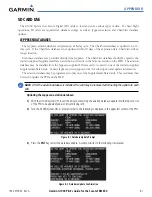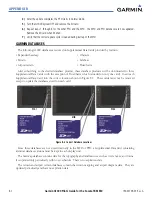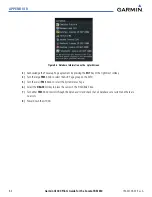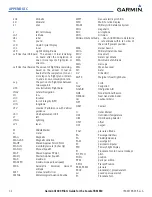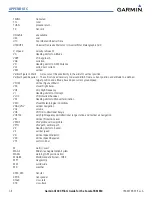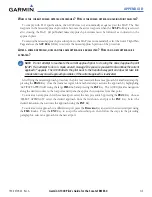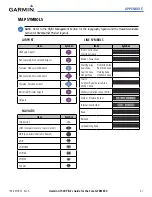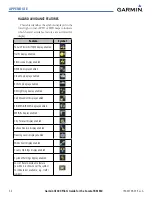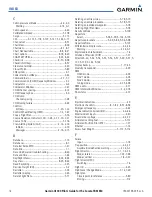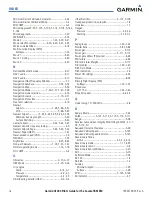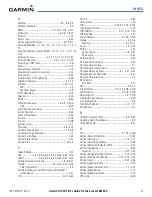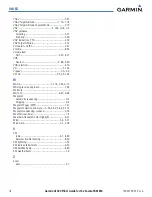
Garmin G1000 Pilot’s Guide for the Socata TBM 850
190-00709-00 Rev. A
D-4
APPENDIX D
W
HEN
DOES
THE
CDI
SCALE
CHANGE
?
• When set to ‘Auto’ (default), the GPS CDI scale automatically adjusts to the desired limits based upon the
current phase of flight.
• When a departure procedure is activated, the CDI is scaled for
departure
(0.3 nm).
• The system switches from departure to
terminal
CDI scaling (1.0 nm) under the following conditions:
- The next leg in the departure procedure is not aligned with the departure runway
- The next leg in the departure procedure is not a CA, CD, CF, CI, CR, DF, FA, FC, FD, FM, IF, or TF leg
(see Glossary for leg type definitions)
- After any leg in the departure procedure that is not a CA or FA leg
• At 30 nm from the departure airport the
enroute
phase of flight is automatically entered and CDI scaling
changes to 2.0 nm over a distance of 1.0 nm, except under the following conditions:
- When navigating with an active departure procedure, the flight phase and CDI scale will not change until
the aircraft arrives at the last departure waypoint (if more than 30 nm from the departure airport) or the leg
after the last departure waypoint has been activated or a direct-to waypoint is activated.
• If after completing the departure procedure the nearest airport is more than 200 nm away from the aircraft
and the approach procedure has not yet commenced, the CDI is scaled for oceanic flight (2.0 nm).
• Within 31 nm of the destination airport (
terminal
area), the CDI scale gradually ramps down from 2.0 nm
to 1.0 nm over a distance of 1.0 nm, except under the following conditions:
- When navigating with an active arrival route, the flight phase and CDI scale will not change until the
aircraft arrives at the first waypoint in the arrive route (if within 31 nm from the destination airport).
• During
approach,
the CDI scale ramps down even further. This transition normally occurs within 2.0 nm
of the Final Approach Fix (FAF). The CDI switches to approach scaling automatically once the approach
procedure becomes active or if Vectors-To-Final (VTF) are selected.
- If the active waypoint is the FAF, the ground track and the bearing to the FAF must be within 45° of the
final approach segment course.
- If the active waypoint is part of the missed approach procedure, the active leg and the preceding missed
approach legs must be aligned within 3° of the final approach segment course and the aircraft position
must be prior to the turn initiation point.
• When a
missed approach
is activated, the CDI scale changes to 0.3 nm.
• The system automatically switches back to
terminal
mode under the following conditions:
- If the next leg in the missed approach procedure is not aligned with the final approach path
- If the next leg in the missed approach procedure is not a CA, CD, CF, CI, CR, DF, FA, FC, FD, FM, IF, or TF leg
- After any leg in the missed approach procedure that is not a CA or FA leg
W
HY
DOES
THE
HSI
NOT
RESPOND
LIKE
A
VOR
WHEN
OBS
MODE
IS
ACTIVE
?
Unlike a VOR, the CDI scale used on GPS equipment is based on the crosstrack distance to the desired
course, not on the angular relationship to the destination. Therefore, the CDI deflection on the GPS is constant
regardless of the distance to the destination and does not become less sensitive when further away from the
destination.


